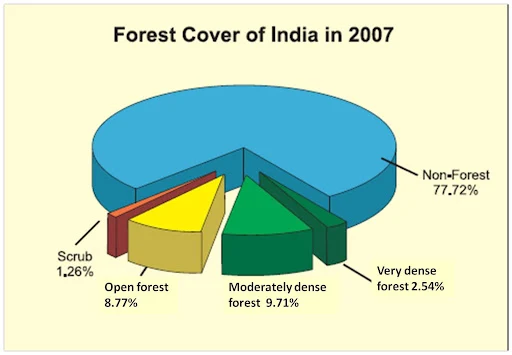Exploring the Status of Forests in India: Trends, Challenges, and Conservation Efforts
In the lush expanse of India's diverse landscape, forests stand as emblematic guardians of biodiversity and ecological balance. Yet, the status of forests in India is a nuanced tapestry of trends, challenges, and ongoing conservation efforts.
*Trends:*
India's forests have witnessed dynamic shifts over the years. From the dense rainforests of the Western Ghats to the deciduous woodlands of central India, each region presents a unique ecological story. Recent trends indicate both encouraging progress and concerning decline. Afforestation initiatives, driven by governmental and non-governmental organizations, have contributed to increasing forest cover. However, rapid urbanization, industrialization, and agricultural expansion have led to deforestation and habitat fragmentation in several regions.
*Challenges:*
Challenges abound in ensuring the sustainability of India's forests. Illegal logging, encroachment, and unsustainable harvesting practices continue to threaten forest ecosystems. Additionally, the impacts of climate change, including erratic rainfall patterns and rising temperatures, pose significant challenges to forest health and resilience. Balancing the needs of local communities dependent on forests for livelihoods with conservation objectives remains a complex challenge for policymakers.
*Conservation Efforts:*
Despite the challenges, concerted efforts are underway to conserve and restore India's forests. The government has implemented various policies and programs such as the National Afforestation Programme and the Compensatory Afforestation Fund Act to enhance forest cover and biodiversity conservation. Moreover, community-based conservation initiatives and partnerships with indigenous communities have proven effective in promoting sustainable forest management practices.
*Conclusion:*
Exploring the status of forests in India unveils a multifaceted narrative of resilience, threats, and conservation endeavors. While the nation grapples with the complexities of balancing development and environmental conservation, there is hope in the collective efforts towards sustainable forest management and biodiversity conservation. By fostering collaboration between stakeholders, embracing innovative technologies, and prioritizing ecosystem integrity, India can chart a path towards a greener, more sustainable future for its forests and the communities reliant upon them.
The status of forests in India is assessed biennially by the Forest Survey of India (FSI), an organization under the Ministry of Environment, Forest and Climate Change (MoEFCC). The latest report, the India State of Forest Report (ISFR) 2021, provides the most recent data1.
Here are the key findings from the ISFR 20211:
- The total forest and tree cover is 24.62% of the geographical area of the country.
- The total forest cover is 7,13,789 sq km, which is 21.71% of the geographical area of the country.
- The tree cover is 2.91% of the geographical area of the country.
- Compared to ISFR 2019, there is an increase of 0.28% of forest and tree cover put together, at the national level. Specifically, forest cover increased by 0.22% and tree cover by 0.76%1.
- The top five states in terms of increase in forest cover are Andhra Pradesh, Telangana, Odisha, Karnataka, and Jharkhand1.
- The total forest cover in the North-Eastern region is 64.66% of its geographical area. However, the current assessment shows a decrease of forest cover to the extent of 1,020 sq km (0.60%) in the region1.
- The mangrove cover in the country has increased by 0.34% compared to the previous assessment1.
- The total carbon stock in forests is estimated as 7,204.0 million tonnes, an increase of 79.4 million tonnes since 20191.
It’s important to note that while India’s forest cover has increased from 7,01,645.79 square kilometres in 2015 to 7,13,534.18 square kilometres in 20212, India also lost 668,400 hectares of forestry between 2015-2020, ranking second globally, right after Brazil2.





.jpeg)



No comments:
Post a Comment
thank you